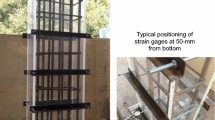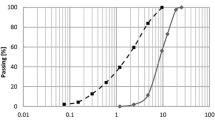Abstract
Self-consolidating concrete (SCC), despite its many positive advantages, increases the formwork lateral pressure of the mixture due to its high fluidity, leading to the increased cost of formwork construction in the in situ concrete structures. The thixotropy property, as the most significant functional feature including the effect of mixture proportions on lateral pressure, was selected to investigate the behavior of fresh concrete in the mold. In the present study, the thixotropy and formwork pressure characteristics (including maximum lateral pressure and pressure drop rate) of 15 SCC mixtures were investigated by considering a number of mixtures proportions variables including cement content, water-to-cement ratio, and mineral admixtures. In addition to studying the effect of these variables on the thixotropy level and the lateral pressure of the formwork, the relationship between the methods of measuring the thixotropy level (hysteresis methods, the area of structural breakdown, and the yield stress growth rate) was evaluated considering the mechanism of these methods. In this study, formwork pressure simulator device was used to measure maximum lateral pressure and lateral pressure drop rate. In addition, the effects of mixture proportioning variables on thixotropy and its relationship with the formwork pressure were studied. Using these indices, the ability to predict the behavior of concrete in the mold was investigated through modeling. The presented predicting model of the formwork pressure based on thixotropy value showed an acceptable correlation coefficient (R2 > 0.77).












Similar content being viewed by others
References
Okamura H, Ouchi M (2003) Self-compacting concrete. J Adv Concr Technol 1(1):5–15
ACI 237R-07 (2007) Self-consolidating concrete. American Concrete Institute, Farmington Hills
BIBM et al (eds) (2004) The European guidelines for self-compacting concrete, Concrete, T.E.G.f.S.C
Khayat K, Omran AF (2010) State-of-the-art review of form pressure exerted by self-consolidating concrete, the ready mixed concrete research and education foundation and the strategic development council. American Concrete Institute, Farmington Hills
Khayat KH, Paultre P, Tremblay S (2001) Structural performance and in-place properties of self-consolidating concrete used for casting highly reinforced columns. Mater J 98(5):371–378
Skarendahl Å (2000) First international RILEM symposium on self-compacting concrete. Mater Struct 33(2):143–144
Nehdi ML (2013) Only tall things cast shadows: opportunities, challenges and research needs of self-consolidating concrete in super-tall buildings. Constr Build Mater 48:80–90
Team PCI Self-Consolidating Concrete FAST (2003) Interim guidelines for the use of self-consolidating concrete in PCI Member plants. PCI J 48(3):14–18
Hanehara S, Yamada K (2008) Rheology and early age properties of cement systems. Cem Concr Res 38(2):175–195. https://doi.org/10.1016/j.cemconres.2007.09.006
Wallevik OH, Wallevik JE (2011) Rheology as a tool in concrete science: the use of rheographs and workability boxes. Cem Concr Res 41(12):1279–1288
Ahari RS, Erdem TK, Ramyar K (2015) Thixotropy and structural breakdown properties of self consolidating concrete containing various supplementary cementitious materials. Cem Concr Compos 59:26–37
Roussel N (2007) Rheology of fresh concrete: from measurements to predictions of casting processes. Mater Struct 40(10):1001–1012
Roussel N (2006) A thixotropy model for fresh fluid concretes: theory, validation and applications. Cem Concr Res 36(10):1797–1806
Assaad J, Kamal H, Khayat (2005) Kinetics of formwork pressure drop of self-consolidating concrete containing various types and contents of binder. Cem Concr Res 35(8):1522–1530
Hunter RJ (2001) Foundations of colloid science. Oxford University Press, Oxford
Wallevik JE (2003) Rheology of particle suspensions: fresh concrete, mortar and cement paste with various types of lignosulfonates. Fakultet for ingeniørvitenskap og teknologi, Trondheim
Tattersall GH, Banfill PFG (1983) The rheology of fresh concrete. Pitman Books Limited, Boston
Roussel N, Cussigh F (2008) Distinct-layer casting of SCC: the mechanical consequences of thixotropy. Cem Concr Res 38(5):624–632
Ish-Shalom M, Greenberg SA (1960) The rheology of fresh Portland cement pastes. In: Proceedings of the 4th international symposium on the chemistry of cement. Monograph 43. National Bureau of Standards, Washington DC, pp 731–748
Assaad J, Khayat KH, Mesbah H (2003) Assessment of thixotropy of flowable and self-consolidating concrete. Mater J 100(2):99–107
Ferron RP, Gregori A, Sun Z, Shah SP (2007) Rheological method to evaluate structural buildup in self-consolidating concrete cement pastes. ACI Mater J 104(3):242
Omran AF, Khayat KH (2014) Choice of thixotropic index to evaluate formwork pressure characteristics of self-consolidating concrete. Cem Concr Res 63:89–97
Gregori A, Ferron RP, Sun Z, Shah SP (2008) Experimental simulation of self-consolidating concrete formwork pressure. ACI Mater J 105(1):97
Assaad JJ, Khayat KH (2006) Effect of mixture consistency on formwork pressure exerted by highly flowable concrete. J Mater Civ Eng 18(6):786–791
Assaad J, Khayat KH (2005) Effect of coarse aggregate characteristics on lateral pressure exerted by self-consolidating concrete. ACI Mater J 102(3):145
Perrot A, Amziane S, Ovarlez G, Roussel N (2009) SCC formwork pressure: influence of steel rebars. Cem Concr Res 39(6):524–528
Khayat K, Assaad J, Mesbah H, Lessard M (2005) Effect of section width and casting rate on variations of formwork pressure of self-consolidating concrete. Mater Struct 38(1):73–78
Assaad JJ, Khayat KH (2006) Effect of casting rate and concrete temperature on formwork pressure of self-consolidating concrete. Mater Struct 39(3):333–341
Khayat KH, Assaad JJ (2006) Effect of w/cm and high-range water-reducing admixture on formwork pressure and thixotropy of self-consolidating concrete. ACI Mater J 103(3):186
Assaad JJ, Khayat KH (2006) Effect of viscosity-enhancing admixtures on formwork pressure and thixotropy of self-consolidating concrete. ACI Mater J 103(4):280
Assaad J (2004) Formwork pressure of self-consolidating concrete influence of thixotropy. Ph.D. thesis, University of Sherbrooke, Sherbrooke
Teixeira S, Santilli A, Puente I (2016) Analysis of casting rate for the validation of models developed to predict the maximum lateral pressure exerted by self-compacting concrete on vertical formwork. J Build Eng 6:215–224
Henschen JD, Castaneda DI, Lange DA (2018) Formwork pressure model for self-consolidating concrete using pressure decay signature. ACI Mater J 115(3):339–348
PCI (2003) Interim guidelines for the use of self-consolidating concrete in precast/prestressed concrete institute plants, (TR-6-03). Precast/Prestressed Concrete Institute, Chicago
BS EN 12390-3:2009 (2009) Testing hardened concrete. Compressive strength of test specimens. ISBN 9780580766589
American Society for Testing and Materials (1967) Standard specification for portland cement. American Society for Testing and Materials, West Conshohocken
Fuller WB, Thompson SE (1907) The laws of proportioning concrete. Trans Am Soc Civ Eng 59:67–143
Khayat K, Omran AF (2010) Evaluation of SCC formwork pressure. J Concr Int 32(6):30–34
Ghoddousi P, Shirzadi Javid AA, Lotfi M (2016) The effect of amount and several different types of mineral admixtures on the yield stress and plastic viscosity of self-consolidating concretes. Amirkabir J Sci Res Civ Environ Eng 48(3):99–102
Sobhani J, Najimi M, Pourkhorshidi AR, Parhizkar T (2010) Prediction of the compressive strength of no-slump concrete: a comparative study of regression, neural network and ANFIS models. Constr Build Mater 24(5):709–718
Lowke D, Kränkel T, Gehlen C, Peter, Schießl (2010) Effect of cement on superplasticizer adsorption, yield stress, thixotropy and segregation resistance. In: Khayat K, Feys D (eds) Design, production and placement of self-consolidating concrete. Springer, Dordrecht, pp 91–101
Paternoster R, Brame R, Mazerolle P, Piquero A (1998) Using the correct statistical test for the equality of regression coefficients. Criminology 36(4):859–866
Acknowledgements
The authors would like to acknowledge the vice chancellery for research and technology of Iran University of Science and Technology (IUST) for the support of this research.
Funding
No funding was received for this research.
Author information
Authors and Affiliations
Corresponding author
Ethics declarations
Conflict of interest
The authors of this study certify that they have no affiliations with or involvement in any organization or entity with any financial interest (such as honoraria; educational grants; participation in speakers’ bureaus; membership, employment, consultancies, stock ownership, or other equity interest; and expert testimony or patent-licensing arrangements), or non-financial interest (such as personal or professional relationships, affiliations, knowledge, or beliefs) in the subject matter or materials discussed in this.
Rights and permissions
About this article
Cite this article
Ghoddousi, P., Shirzadi Javid, A.A., Ghodrati Amiri, G. et al. Predicting the Formwork Lateral Pressure of Self-consolidating Concrete Based on Experimental Thixotropy Values. Int J Civ Eng 17, 1131–1144 (2019). https://doi.org/10.1007/s40999-018-0368-y
Received:
Revised:
Accepted:
Published:
Issue Date:
DOI: https://doi.org/10.1007/s40999-018-0368-y




